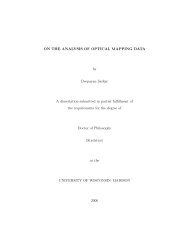Struggles with Survey Weighting and Regression Modeling paper
Struggles with Survey Weighting and Regression Modeling paper
Struggles with Survey Weighting and Regression Modeling paper
Create successful ePaper yourself
Turn your PDF publications into a flip-book with our unique Google optimized e-Paper software.
164 A. GELMAN<br />
if either, of the two estimates makes sense. A parallel<br />
approach is through simulation studies—for greater realism,<br />
these can often be constructed using subsamples<br />
of actual surveys—as well as theoretical studies of the<br />
bias <strong>and</strong> variance of poststratified estimates <strong>with</strong> moderate<br />
sample sizes. In addition, a full hierarchical modeling<br />
approach should be able to h<strong>and</strong>le cluster sampling<br />
(which we have not considered in this article)<br />
simply as another grouping factor.<br />
We would like a general modeling procedure that<br />
gives believable estimates for time trends <strong>and</strong> as a<br />
byproduct produces a good set of weights that can be<br />
used for simple estim<strong>and</strong>s. Given the difficulties <strong>with</strong><br />
current methods for weighting <strong>and</strong> modeling, we believe<br />
this approach is of both practical <strong>and</strong> theoretical<br />
interest.<br />
ACKNOWLEDGEMENTS<br />
We thank Samantha Cook, John Carlin, Julian Teitler,<br />
S<strong>and</strong>ra Garcia, Danny Pfeffermann <strong>and</strong> several reviewers<br />
for helpful discussions <strong>and</strong> comments, <strong>and</strong> the National<br />
Science Foundation for financial support.<br />
REFERENCES<br />
BECKER, D. E. (1998). The New York City Social Indicators <strong>Survey</strong>:<br />
An analysis of the weighting procedure. Technical report,<br />
School of Social Work, Columbia Univ.<br />
BINDER, D. A. (1983). On the variances of asymptotically normal<br />
estimators from complex surveys. Internat. Statist. Rev. 51 279–<br />
292. MR0731144<br />
CENTRE FOR MULTILEVEL MODELLING (2005). Software<br />
reviews of multilevel analysis packages. Available<br />
at www.cmm.bristol.ac.uk/learning-training/multilevel-msoftware/index.shtml.<br />
COOK, S.R.<strong>and</strong>GELMAN, A. (2006). <strong>Survey</strong> weighting <strong>and</strong> regression.<br />
Technical report, Dept. Statistics, Columbia Univ.<br />
DEMING, W.E.<strong>and</strong>STEPHAN, F. F. (1940). On a least squares<br />
adjustment of a sampled frequency table when the expected<br />
marginal totals are known. Ann. Math. Statist. 11 427–444.<br />
MR0003527<br />
DEVILLE, J.,SARNDAL, C.<strong>and</strong>SAUTORY, O. (1993). Generalizing<br />
raking procedures in survey sampling. J. Amer. Statist. Assoc.<br />
88 1013–1020.<br />
DUMOUCHEL, W.H.<strong>and</strong>DUNCAN, G. J. (1983). Using sample<br />
survey weights in multiple regression analyses of stratified samples.<br />
J. Amer. Statist. Assoc. 78 535–543.<br />
ELLIOTT, M.R.<strong>and</strong>LITTLE, R. J. A. (2000). Model-based alternatives<br />
to trimming survey weights. J. Official Statistics 16<br />
191–209.<br />
FAY, R.E.<strong>and</strong>HERRIOT, R. A. (1979). Estimates of income for<br />
small places: An application of James–Stein procedures to census<br />
data. J. Amer. Statist. Assoc. 74 269–277. MR0548019<br />
GARFINKEL, I.,KAUSHAL, N.,TEITLER, J.<strong>and</strong>GARCIA, S.<br />
(2003). Vulnerability <strong>and</strong> resilience: New Yorkers respond to<br />
9/11. Technical report, School of Social Work, Columbia Univ.<br />
GARFINKEL, I.<strong>and</strong>MEYERS, M. K. (1999). New York City social<br />
indicators 1997: A tale of many cities. Technical report, School<br />
of Social Work, Columbia Univ.<br />
GELMAN, A. (2006). Prior distributions for variance parameters in<br />
hierarchical models. Bayesian Anal. 1 515–533. MR2221284<br />
GELMAN, A.<strong>and</strong>CARLIN, J. B. (2002). Poststratification <strong>and</strong><br />
weighting adjustments. In <strong>Survey</strong> Nonresponse (R.M.Groves,<br />
D. A. Dillman, J. L. Eltinge <strong>and</strong> R. J. A. Little, eds.) 289–302.<br />
Wiley, New York.<br />
GELMAN, A.,CARLIN, J.B.,STERN, H.S.<strong>and</strong>RUBIN, D.B.<br />
(2004). Bayesian Data Analysis, 2nd ed. CRC Press, London.<br />
MR2027492<br />
GELMAN,A.<strong>and</strong>HILL, J. (2007). Data Analysis Using <strong>Regression</strong><br />
<strong>and</strong> Multilevel/Hierarchical Models. Cambridge Univ. Press.<br />
GELMAN, A.<strong>and</strong>LITTLE, T. C. (1998). Improving on probability<br />
weighting for household size. Public Opinion Quarterly 62<br />
398–404.<br />
GRAUBARD, B.I.<strong>and</strong>KORN, E. L. (2002). Inference for superpopulation<br />
parameters using sample surveys. Statist. Sci. 17 73–<br />
96. MR1910075<br />
HOLT, D.<strong>and</strong>SMITH, T. M. F. (1979). Post stratification. J. Roy.<br />
Statist. Soc. Ser. A 142 33–46.<br />
KISH, L. (1992). <strong>Weighting</strong> for unequal P i . J. Official Statistics 8<br />
183–200.<br />
LAZZERONI, L.C.<strong>and</strong>LITTLE, R. J. A. (1998). R<strong>and</strong>om-effects<br />
models for smoothing poststratification weights. J. Official Statistics<br />
14 61–78.<br />
LITTLE, R. J. A. (1991). Inference <strong>with</strong> survey weights. J. Official<br />
Statistics 7 405–424.<br />
LITTLE, R. J. A. (1993). Post-stratification: A modeler’s perspective.<br />
J. Amer. Statist. Assoc. 88 1001–1012.<br />
LOHR, S. (1999). Sampling: Design <strong>and</strong> Analysis. Duxbury, Pacific<br />
Grove, CA.<br />
LU, H.<strong>and</strong>GELMAN, A. (2003). A method for estimating designbased<br />
sampling variances for surveys <strong>with</strong> weighting, poststratification<br />
<strong>and</strong> raking. J. Official Statistics 19 133–151.<br />
MEYERS, M.K.<strong>and</strong>TEITLER, J. O. (2001). New York City social<br />
indicators 1999: Pulling ahead, falling behind. Technical report,<br />
School of Social Work, Columbia Univ.<br />
PARK, D.K.,GELMAN, A.<strong>and</strong>BAFUMI, J. (2004). Bayesian<br />
multilevel estimation <strong>with</strong> poststratification: State-level estimates<br />
from national polls. Political Analysis 12 375–385.<br />
PFEFFERMANN, D. (1993). The role of sampling weights when<br />
modeling survey data. Internat. Statist. Rev. 61 317–337.<br />
RAO, J. N. K. (2003). Small Area Estimation. Wiley, Hoboken, NJ.<br />
MR1953089<br />
RUBIN, D. B. (1976). Inference <strong>and</strong> missing data (<strong>with</strong> discussion).<br />
Biometrika 63 581–592. MR0455196<br />
RUBIN, D. B. (1996). Multiple imputation after 18+ years (<strong>with</strong><br />
discussion). J. Amer. Statist. Assoc. 91 473–520.<br />
VOSS, D.S.,GELMAN, A.<strong>and</strong>KING, G. (1995). Preelection<br />
survey methodology: Details from eight polling organizations,<br />
1988 <strong>and</strong> 1992. Public Opinion Quarterly 59 98–132.<br />
YUNG, W.<strong>and</strong>RAO, J. N. K. (1996). Jackknife linearization variance<br />
estimators under stratified multi-stage sampling. <strong>Survey</strong><br />
Methodology 22 23–31.
















